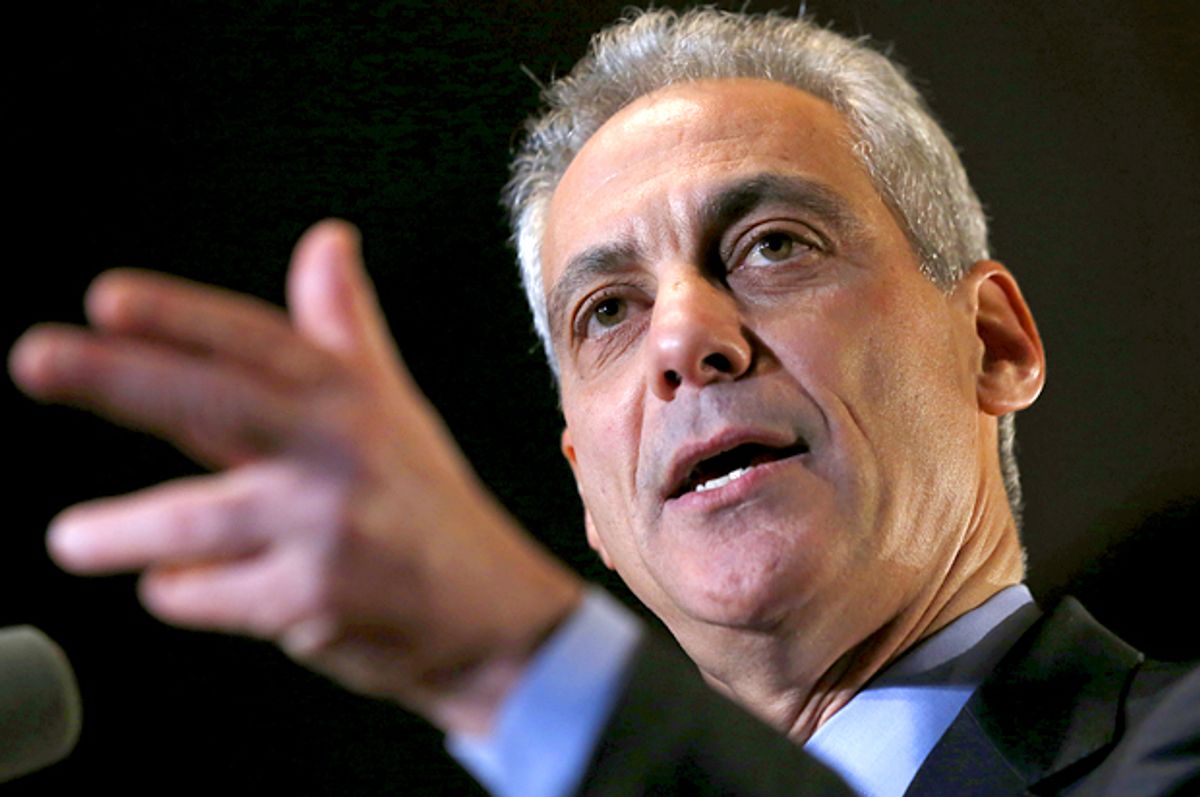In June 2012, an activist writing under the name Tarheel Dem described his arrest on May 17, 2012, with a group of other activists in advance of the NATO summit in Chicago. For most of a day, he was held, shackled, without his heart medications, in a location in western Chicago before being released with no charges. He described being held where lawyers couldn't find him. "I was held over 12 hours before the National Lawyers Guild could find me; essentially, I was in a black site." Contemporary reporting of the detentions described the activists being "disappeared."
A confluence of events has brought newfound attention to the location of this detention site, the Organized Crime Bureau in Homan Square, and the Chicago Police Department tactics that have been used there.
Last week the Guardian, following earlier reporting that had made the connection, described the role a Chicago Police Department murder detective, Richard Zuley, played in the wrongful conviction in 1990 of Lathierial Boyd. In a civil suit, Boyd now accuses Zuley of planting the evidence that led to him spending 23 years in prison for a crime he didn't commit. But it's not just in Chicago where Zuley has been tied to abuse: After allegedly mistreating Boyd and others -- including long-term shackling and threats -- while at CPD, in 2003 Zuley would go on to lead a team at Guantánamo Bay Naval Base detention center, overseeing one of the most notable plans of torture to take place there, that of Mauritanian Mohamedou Ould Slahi. Along with subjecting Slahi to sleep deprivation and a fake rendition on a motorboat, Zuley threatened Slahi's mother with rendition to Gitmo. (Slahi's recently published memoir, "Guantánamo Diary," reached the New York Times bestseller list shortly after it was published.)
Richard Zuley, in short, is a direct link between the detention and torture of innocent men in Gitmo and wrongful detention and abuse of African-Americans in Chicago. Our war on terror and police assault on minorities in one person.
In a follow-up to its stories on Zuley, the Guardian described Homan Square, using the same language of black sites and disappearances used to describe the NATO activists' detention. “It’s sort of an open secret among attorneys that regularly make police station visits, this place – if you can’t find a client in the system, odds are they’re there,” the Guardian quoted Chicago lawyer Julia Bartmes.
One after another of Chicago's local outlets have reprinted CPD's limited denials that they disappear people at the location. Detainees at Homan Square are treated just like detainees elsewhere, the Sun Times quoted CPD spokesperson Marty Maloney explaining. Yet, those familiar with Homan Square point to the hole in Maloney's claim that, “If lawyers have a client detained at Homan Square, just like any other facility, they are allowed to speak to and visit them."
Unlike the NATO protesters, who knew to call the National Lawyers Guild, many people detained at Homan Square don't yet have lawyers.
As the executive director of the Chicago Justice Project, Tracy Siska, explained in an interview with the Atlantic, arrestees get brought to Homan Square prior to being charged, making it easier to interrogate people for extended periods without a lawyer. "What used to happen at Homan Square is that prior to a year ago, if you get arrested and you get brought down anywhere in any district, you would not pop up in the city computer as being arrested until they processed the police report, which could take anywhere from an hour to 15 hours," Siska explained. "If they 'arrested' you, then they have to report it. But if they don’t 'arrest you,' nefarious things could happen and they could interrogate you without a lawyer." The scheme worked because most of the people brought to Homan Square -- "black and brown and poor kids" involved in the drug war, according to Siska -- don't get lawyers until being assigned one by a court.
That is, in addition to a building on the west side of Chicago, this is a ploy designed to extend the time during which authorities can interrogate men without the intervention of a lawyer. This ploy is not limited to Homan Square. The government has used it increasingly in high-profile terrorism cases, most notably when Boston Marathon bomb defendant Dzhokhar Tsarnaev was interviewed for a weekend even as he demanded a lawyer; so long as the government didn't "present" him to a judge, they managed to avoid giving the accused terrorist a lawyer. Gitmo was designed to take this to an extreme; in early years, the government tried to prevent detainees from ever obtaining a lawyer, and in recent years lawyers have repeatedly had to fight to continue to represent their clients after their habeas corpus cases were denied. But it can happen anywhere a local cop delays the time before officially processing a detainee.
The exchange between the war on terror and regular police work (especially the war on drugs) goes both ways -- as Chicago's previous torture abuses under Jon Burge made clear long before Zuley renewed the exchange.
A myriad of developments has focused new attention on Chicago's black site: Boyd's suit, the Guardian's reporting, increased pressure for Chicago to compensate Burge's victims. The mayoral election surely didn't hurt. And Rahm Emanuel's failure to win outright Tuesday may focus more national attention on the things he has done to piss off Chicago's communities of color, of which policing is just one small part.
Whether it's the war on drugs or the war on terror, authorities increasingly search out dark sites to hide abuse. This site on the west side of Chicago is a perfect first step to make such darkness visible.

Shares